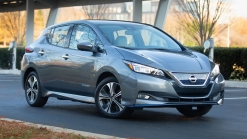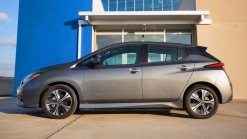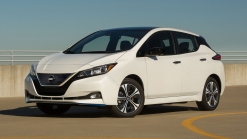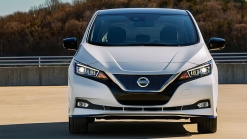2021 Nissan Leaf Review | Variety Of Ranges, Features Is Its Strength

The 2021 Nissan Leaf is one of the longest-running electric car nameplates on the market, which partly explains why it's the bestselling electric car in the world. As for why you might be interested in one now, much of its appeal is its wide range of trims and, well, ranges. Its more affordable base models have a less-powerful motor and will go about 150 miles on a charge. But if you need to travel longer distances, or would appreciate some extra peace of mind, the available Leaf Plus can go 226 miles. Either way, you get a rather spacious hatchback with a comfortable ride and refined powertrain. All of these features make it well worth considering against similar offerings such as the Chevy Bolt EV, Hyundai Kona Electric, Kia Niro EV and entry-level Tesla Model 3.
For 2021, the Nissan Leaf is unchanged. But it's worth noting that last year Nissan added more equipment to more of the range. All models received front and rear automatic emergency braking, rear-cross traffic alert, blind-spot monitoring, automatic high-beam headlights and lane-keep assist. Other safety features added include knee airbags and seat-mounted rear side airbags. The base trim levels also picked up a standard 8-inch infotainment screen and Apple CarPlay and Android Auto.
Nissan positions the Leaf and Leaf Plus as budget options in the EV world, which means the interior feels a bit cheap. Hard black plastics dominate most surfaces, and the seats are cloth except for the most expensive SL that gets leather. This interior was totally revamped for the 2018 redesign, and so it feels modern with a big infotainment display and a digital screen with lots of information in the instrument cluster.
All Leaf models have an 8-inch screen. It features customizable icon layouts, multi-touch gestures like pinch-to-zoom and the capability of software updates over Wi-Fi. Every Leaf includes wired Apple CarPlay and Android Auto, and the touchscreens themselves are pretty easy to use.
Nissan doesn't go above and beyond with other interior features, but there are some niceties worth mentioning. An eight-way power driver's seat is optional, as are heated seats. A Bose seven-speaker stereo comes standard with the SL trim. Automatic climate control is also a standard feature. SV models and up get a heat-pump heater, which is a perk for an electric car, as it’s much more efficient and will likely help preserve some of your range when running it.
The Nissan Leaf is a hatchback, predictably making it super practical for its size. Compared to its closest competition, the Chevrolet Bolt EV and Hyundai Kona Electric, it's just about average for passenger interior space. Nissan wins by a couple inches when it comes to front headroom and legroom, but gives those inches back when it comes to the snug rear seat. There's plenty of headroom in every seat for passengers over 6 feet tall, though.
It's considerably longer than its competitors, both overall and in wheelbase, which could contribute to the Leaf's supple ride. With all the seats in their upright position, this extra length contributes to more cargo space in the hatch than others, at 23.6 cu-ft. The seats do fold down, but the Bolt's cargo area ends up becoming far more expansive in full luggage capacity position (the new Bolt EUV is even bigger when you lower the seats). A base Nissan Leaf weighs as little as 3,501 pounds, but a top-trim Leaf Plus balloons all the way up to 3,914 pounds. A few hundred pounds is a noticeable difference, but the extra range and power are the upsides.
The Leaf has a single permanent magnet electric motor powering the front wheels, making 147 horsepower and 236 pound-feet of torque. Nissan says that's good for 0-60 mph in about 8 seconds, which is perfectly acceptable for a compact hatchback. Base range for this 40-kilowatt-hour version is 150 miles.
Nissan made a few tweaks to the electric motor for the big-battery Leaf Plus, which pumps its output up to 214 horsepower and 250 pound-feet of torque. All that extra power brings the 0-60 mph time down to about 7 seconds. Top speed is limited to 98 mph. Range for the Leaf Plus and its 62-kWh battery pack is 226 miles, which isn't that far off top competitors, which are around 250. The Leaf Plus is also capable of charging faster than the normal Leaf, providing 100-kW DC fast charging whereas the 40-kWh model has 50-kW charging. Nissan says that in ideal conditions, you'll be able to get 180 miles of charge in 45 minutes with the Plus. That compares with the 40 minutes needed to recoup 120 miles of range in the base Leaf.
Unlike most other electric cars on the market, the Leaf’s DC fast-charging port is a CHAdeMO design. So when you’re planning a trip and planning on using fast charging, make sure stations along the route have a CHAdeMO charger, and not just the more common CCS charger.
We've driven both the normal Leaf and Leaf Plus, and both are super-comfortable commuter cars. Neither is particularly quick, but the Plus steps it up a level beyond the regular Leaf. There's a much stronger shove into the seat from the more powerful electric motor, which explains the 1-second reduction in acceleration times. The Leaf's throttle tuning is also very smooth compared to other EVs, though it sacrifices a bit of the competition's more instant response.
While many EVs can be shockingly fun to drive, the Leaf merely handles at an acceptable level. A lack of steering feel is the car's Achilles heel, and it's less agile than its competition. It's clear Nissan hasn't aimed the driving feel at enthusiasts, but rather those who prioritize a smooth, comfortable ride. It succeeds in spades around town, soaking up potholes and road imperfections with ease, never jarring the passengers inside. Electric versions of the Kona and Niro aren't exactly loud and uncomfortable, but the Leaf offers more refinement in daily driving. Less road noise seeps into the Leaf's cabin, and the Kona/Niro cousins feel a bit stiffer over rough roads.
Our review of the long-range Leaf Plus model, including what you can expect from its range and better performance.
Our initial review of the Leaf when the current generation was introduced for 2018. Included are information about it design and engineering, and driving impressions with the base battery.
Pricing for the 2021 Nissan Leaf starts at $32,620 including the $950 destination charge for the base S trim. Step up to the long-range Plus, and the base price pops up to $39,220. That's a $6,600 price increase for the extra range and power. All Nissan Leafs are still eligible for a $7,500 federal tax credit.
Standard equipment for the S includes 16-inch steel wheels, automatic halogen headlights, cloth seats, an 8-inch center infotainment screen, a 7-inch instrument cluster display, push-button start and a USB port. The S Plus swaps the steel wheels for 16-inch aluminum alloys, adds a front lip spoiler, a portable charge cable, an 8-inch touchscreen and automatic climate control. The S Plus also gets a standard 100-kW fast-charging port. The short-range S has a fast-charging port available for an extra $1,690, though it only supports 50-kW fast charging, as that’s all that Nissan offers on the short-range models.
If you’re considering a short-range Leaf, we would strongly recommend moving up to the SV, which includes the 50-kW fast-charging port as standard, plus it adds larger 17-inch wheels, a more efficient heat pump for heating, heated seats, a heated leather steering wheel, navigation and a six-speaker sound system. And all of those features only add $3,290 to the base price for a total of $35,910. All those features carry over to the SV Plus as well, and of course it has a 100-kW fast-charging port like the S Plus, and it starts at $41,470.
The top SL trim is only available with the long-range battery. It adds LED lighting, a Bose sound system, standard ProPilot Assist (which you can read more about below), a surround-view camera system, power-adjustable leather seats and an auto-dimming rear-view mirror. It starts at $44,920.
You can read a full breakdown of Nissan Leaf features, specs and local pricing here on Autoblog.
All 2021 Leaf models come standard with more standard driver assistance tech than usual. These include automatic emergency braking both front and rear, rear cross-traffic alert, blind-spot monitoring, lane-departure warning, lane-keep assist and automatic high-beam headlights. To take advantage of any of Nissan's active safety tech you'll need to upgrade to the SV or SL trim. It’s an option for the SV and standard for the SL
ProPilot Assist is one of the better driving aids on offer out there. The lane-centering keeps it in the lane around bends on the highway, and the adaptive cruise is traffic-jam friendly, coming to a stop then starting on its own if you're stationary for three seconds or less.
The federal government gives the Nissan Leaf an overall score of five stars out of five. In individual tests, it received four-star ratings for frontal and rollover crashes, and a five-star rating for side crashes. The Insurance Institute for Highway Safety has evaluated the current generation of Leaf, but not in every type of crash test. It received "Good" ratings in the moderate front overlap and side crash tests. It received a "Moderate" for its rear child LATCH ease of use.







